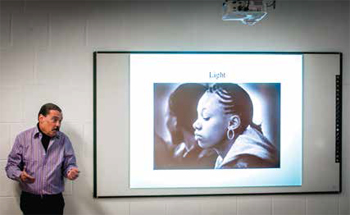
When intimacy is established, you become invisible. While this may be a disastrous outcome where romance is concerned, it is essential for the photojournalist because only when the photographer disappears from the scene does the subject truly show him- or herself. For three days in April, in a kind of haiku version of a semester-long course, Colby-Sawyer students looked at their college and its surrounding communities through a new lens—that of photojournalist—and learned the art of being invisible.
Just before 6 p.m. on a Friday, many Colby-Sawyer students reveled outside in the last moments of sunshine before a night with friends. Inside Reichhold 113, which served as classroom and newsroom for the one-credit course, the shades were drawn, and 15 students sat stationed before wide-screen Macs. Quiet conversations flowed through the room as the beginning of “ART250A: Photojournalism” with former LIFE magazine photographer John Shearer P'14 drew near.
Composed mostly of seniors and Media Studies majors, the group had photography backgrounds that ranged from those with zero formal classes and borrowed cameras to aspiring professionals. Their mission was to shoot an assignment and create their own individual four-page story on Saturday, then edit it down to a spread to combine with the others' to create a Day in the Life compilation by 6 p.m. on Sunday.
In short, they were there to tell stories.
“A picture story, like apiece by Bach, has a rhythm to it; it ebbs and flows,” Shearer said in his Friday night lecture.” There are big pictures and there are detail shots that draw you in. Be conscious of energy levels and feelings.”
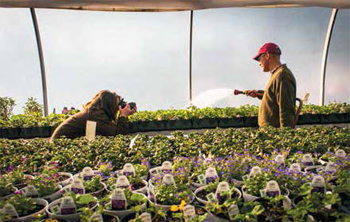
To show those energy levels and feelings—to capture the intimacy of a life usually kept under wraps and out of sight—the photographer must become invisible. “You've got to get your subject in the mind-set that you're not there,” Shearer told his students, even while urging them to find the nerve to get in close and capture dramatic moments. “You have to be invisible. It's the key to what we do.” It's a lesson Shearer learned while trying to find a New York City street gang he could shadow in 1972 for what became one of his seminal picture stories, “The 'Prez' of the Reapers.” He eventually found that gang in the Bronx, and the lesson has lasted longer than the 10-page story LIFE ran as a result.
“I'm going to tell you the rules of the road,” said Shearer, “but we're a maverick art form, and half the time we don't follow the rules. One thing is for certain, though: Light is the whole thing. Look at the light; you're painting with light. So get up early. And remember, straight-on smiling pictures are very boring. Move your camera around, and don't come back here with a lot of lame eye-level shots.”
Getting the Picture
On Saturday morning, the students were dispatched to their assignments, which included Spring Ledge Farm, the Lake Sunapee Region VNA and Hospice, a local inn, the hospital, and the police and fire departments in New London, as well as a nearby alpaca farm, airport and other local spots.
Ceramics major Kate Rial '13 of Pennsylvania installed herself early at Morgan Hill Bookstore on New London's Main Street and waited with co-owner Peggy Holliday for customers to arrive. Spanish guitar music in the background accompanied the sound of Rial's camera shutter as she shot portraits of Holliday.
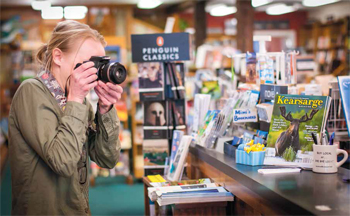
“I came to Colby-Sawyer as an Athletic Training major and was actually really trying not to do art, since a future in it kind of scared me, but I took a ceramics class with David Ernster and thought, Wow—this is what I'm supposed to do,” said Rial, looking around for her next picture. “I took one photography class as a freshman, but I learned so much from John last night and would love to take more classes.”
A mother and daughter looking for wedding and birthday gifts entered the store. Rial quickly explained her camera and was granted permission to shoot. Without hesitation, Rial followed the girl, about six, to the children's section. She was oblivious, and Rial documented the girl's contemplation of book titles and her small smile that signaled a decision. The girl pulled a book off a shelf and joined her mother at the register, where the gifts were wrapped, and they left to complete more errands.
“Oh!” exclaimed an older gentleman who entered the store and spotted Rial's camera. While Holliday ushered him to the travel section, Rial asked if she could take his photo.
“Well, I don't know,” he said. “Do I look okay?”
“You look great!” Rial assured him.
“Then go ahead. Just send me a copy. No, just kidding. Go ahead,” he said, turning his attention to Arizona guide books. Rial disappeared behind the camera.
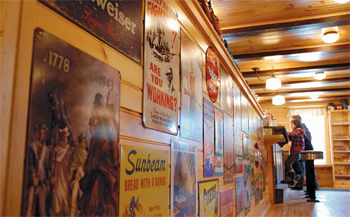
At the register, a woman wearing a hat at a jaunty angle waited to pay for a card for her parents' sixtieth wedding anniversary. “Go ahead and shoot; I won't look at you,” she told Rial without prompting, and Rial slipped out of sight again.
Meanwhile, next door at the fire department, Cynthia Driver '13 had achieved invisibility of a different sort—the gut-twisting kind that happens when your story contact is nowhere to be found, and the clock is ticking. Chilled after standing in the parking lot for hours and making repeated phone calls in hopes of fulfilling her assignment, she finally gave up and hitched a ride to an impromptu redirect. At Vernondale General Store in North Sutton, the lunch counter was packed and the place was hopping. Even so, owner Bob DeFelice listened to Driver's dilemma and request to stay for a couple of hours, and he welcomed her with an easy smile. “Sure, no problem at all,” he said. “This will be great.”
By then all the other students were done shooting and back at their computers in Reichhold. There was an air of excitement, of accomplishment, as they downloaded their images and began selecting which to include in their layouts. Shearer moved from screen to screen. He critiqued pictures with a smile, his voice even and unfailingly upbeat.
“Here, let me show you something about layers and Photoshop,” he told Monique Fontaine '13,finessing her environmental portrait of the Lebanon Municipal Airport manager.
Carly Strathdee '13, a Media Studies major from New Durham, N.H., worked on her images of Spring Ledge Farm and was enthused about her first photography class experience.
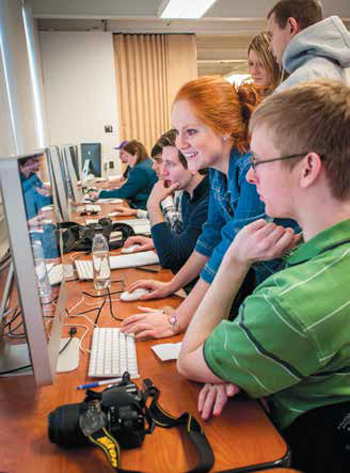
“[Professor of Humanities] Donna Berghorn really plugged this course; she said it would be helpful and fun, and she was right. John is great, and I want to be a reporter, so I think seeing this aspect of journalism is really important,” said Strathdee.
Exposure to photojournalism, minimal though it may have been in such a short class, was Shearer's goal in proposing the course. “Colby-Sawyer offers majors in graphic design and photography, and media studies, but there are no photojournalism courses. The photography program is primarily fine arts, and there's nothing wrong with that, but it would be great to add some commercial application. It was from that standpoint that I thought, Gee, it would be interesting and great to offer something like this course because it sharpens those professional skills. You can harness that and use that. If you want to go be a photographer, it's going to give you some underpinning.
Jess Walton '13, one of the few photography majors in the weekend course, would like to get into travel photography and said she wishes there were a photojournalism aspect of the Colby-Sawyer photography program. “There were only 15 seats for this class, and it filled instantly, with 15 more on the waitlist,” she said. “I feel lucky to be here.”
Over bagels and coffee, the stories came together. By 2 p.m., the room was quiet as the sense of looming deadlines became palpable. Driver returned from Vernondale, hours behind the eight ball but happy with how things went and headed to the dining hall to grab food.
“Is that in New London's library?” a student asked, watching Kate Rial crop an image of bookshelves.
“No,” Rial said. “It's Morgan Hill Bookstore. You know, right on Main Street.”
“Oh. I've never been in there,” said the senior.
The classroom fell silent but for mouse clicks as the photographers made a million editing decisions and crafted their stories. It would be a 13-hour day for some.
By 3 p.m. the next day, the final deadline was in sight and one after another, the individual assignments were laid out. By 5 p.m., there were four to go, and an impatient energy filled the room. “We wrap at six,” Shearer said, and the group met the deadline with five minutes to spare.
“It's been a long day, with a lot of steps,” says Shearer. “You worked hard and did a wonderful job.”
When students come to Colby-Sawyer, they become part of a community within a community. While they study, learn to ask questions and connect the different areas of their liberal arts education—finding the beauty in science, for example, or realizing the extent to which there is science in art—they also find a place in their new home. Their presence may be as quiet as ducking into the grocery story or as loud as riding a wailing fire truck to a scene as a volunteer firefighter, but eventually the newness wears off. With the students' assignments, the familiar became new again; the invisible, visible; the visible, invisible.
by Kate Seamans, College Communications


